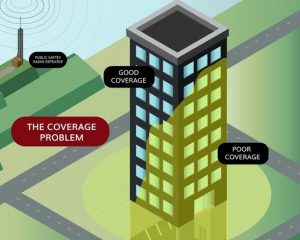What is a BDA? You’re asking the question and we’re giving answers. Here’s a simple breakdown of everything you need to know about Bi-Directional Amplifiers.
What Is A BDA?
A Bi-Directional Amplifier (BDA) is a signal boosting device that sustains two-way communications and amplifies the signal. BDAs work in both transmit and receive mode throughout a facility–including it’s stairwells, underground tunnels, parking garages, and other challenging areas. In short, it is a signal boosting solution designed to enhance in-building radio frequency (RF) coverage for public safety radios.
Why You Need A BDA
Now that we’ve answered your question of “What is a BDA,” we’re going to explain exactly why you need to have one. During an emergency, reliable communication is critical to ensuring a safe solution. Staying both informed and connected with clear radio transmissions between first responders inside the building and emergency personnel outside the building can help prevent injuries and ultimately save lives.
However, emergency responders can easily lose communications when in-building radio signals are weakened by strong structures such as concrete, windows, and metal. Therefore, a BDA system is essential to maximize safety during an emergency by providing reliable communication.
Here are a few key benefits to having a Bi-Directional Amplifier:
- Peace of mind: In the event of an emergency, your building is well-prepared for emergency personnel to arrive.
- Reliable communication: Clear radio transmissions between first responders inside a building and emergency personnel outside the building can prevent further injuries and save more lives– the ultimate goal!
- Effective and efficient results: Our Class B, Bi-Directional Amplifier systems have been tested and evaluated in accordance with UL 2524 1st Edition requirements for in-building 2-way Emergency Radio Communication Enhancement Systems and proven effective on numerous occasions.

Who Needs A BDA
Any building that is identified and inspected under local ordinances and/or is requiring public safety permits should have a BDA to ensure constant two-way communication. In fact, many facilities now require BDA installation with new or renovation permits and certifications. A few examples of buildings that need a Bi-Directional Amplifier system include:
- Airport terminals
- Apartment buildings
- Commercial buildings
- Hospitals
- Hotels
- Parking garages
- Schools and campuses
When in doubt, we encourage you to always check with your local municipality or Fire Department for your local requirements.
Why You Should Choose DynaFire
DynaFire’s FCC GROL certified team will assess your specific buildings needs with an on-site evaluation. We tailor the system design to each unique structure for optimal results. Our designs comply with government mandates and Code Compliance.
Additionally, since we are a full-service organization, our work does not end after design and installation. We also offer maintenance and Test & Inspection services to maintain an effective and reliable BDA system so our clients and emergency personnel can have the peace of mind that, should an emergency happen, communication would go uninterrupted.
Here’s what our client has to say about us: “As a project manager, I interact with many suppliers and subcontractors every day, and it is refreshing to work with a team that is truly dedicated and “on top of it” as is DynaFire. From bid, to submittals, to finished product, DynaFire would be an asset to any project that values professionalism and has pride in delivering a first-rate product from start to finish.” -Brandon Ciraco, Ciraco Electric Inc.
If you’re researching “What is a BDA,” we can help. Contact us today for all of your BDA and Fire & Life Safety needs.






